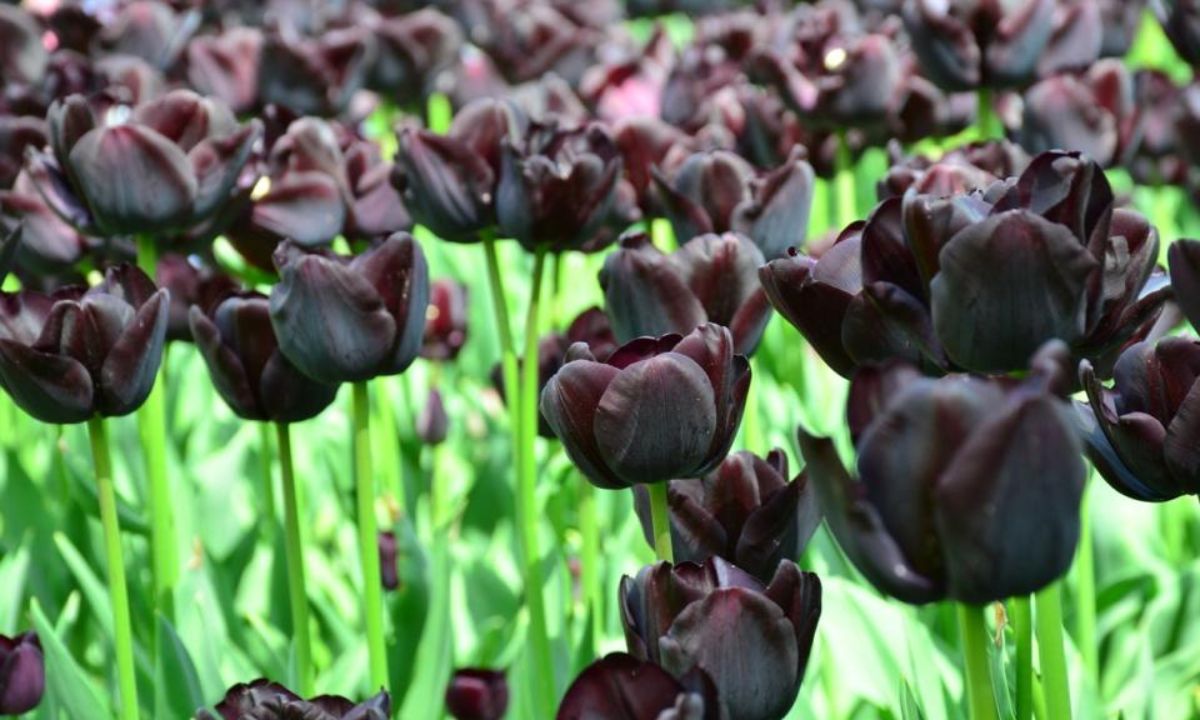The Queen of the Night Tulip (Tulipa ‘Queen of the Night’) is one of the most stunning and unique tulip varieties. Known for its velvety, deep purple to near-black petals, it’s a favorite among gardeners seeking to add elegance and drama to their gardens.
Unlike typical tulips with bright and cheerful hues, this variety creates a sophisticated contrast. Its almost-black blooms shimmer in sunlight, making it an exceptional choice for luxurious garden designs.
Introduced in the 1940s, the Queen of the Night Tulip has become iconic for its mysterious beauty and versatility in landscaping. It’s often paired with lighter-colored flowers to make its dark blooms stand out.
When Introduced
The Queen of the Night Tulip was first introduced in 1944. This tulip was the result of decades of meticulous breeding aimed at producing the darkest tulip possible.
Despite its modern origin, it has quickly become a classic favorite in gardens worldwide, symbolizing luxury and sophistication.
Where to Plant Queen of the Night Tulip
These tulips are versatile and thrive in various locations as long as they receive the right conditions. Here are ideal spots for planting:
- Garden Beds: Showcase their dark blooms in formal or informal garden layouts.
- Borders: Use them to create a striking border along pathways or walls.
- Containers: Plant in pots to place on patios or balconies for a dramatic display.
For the best results, choose locations with full sunlight or partial shade, especially in warmer regions. Pair them with lighter-colored plants like white or yellow tulips to create stunning visual contrasts.
How and When to Plant Queen of the Night Tulip?

When to Plant
Plant Queen of the Night Tulip bulbs in the fall (September to November), before the ground freezes. Soil temperatures should be around 60°F (15°C) for optimal rooting. This timing allows the bulbs to establish roots before winter, ensuring robust growth in spring.
How to Plant Queen of the Night Tulip?
Prepare the Soil
- Ensure the soil is well-draining and rich in organic matter.
- If you have clay-heavy soil, amend it with compost or sand to improve drainage.
Planting Depth
- Dig holes or a trench about 6-8 inches deep (approximately three times the height of the bulb).
- Space the bulbs 4-6 inches apart to allow proper growth and airflow.
Place the Bulbs
- Position the bulbs with their pointed end facing upward.
- Cover them with soil and gently press to eliminate air pockets.
Water
- After planting, water the bulbs thoroughly to settle the soil. Avoid overwatering, as soggy soil can cause bulb rot.
Mulch
- Apply a layer of mulch to insulate the bulbs during winter and retain soil moisture. This also helps prevent weed growth.
Also See This Post: How to Plant and Grow Bloomerang Lilac_2024 guide
Queen of the Night Tulip Care Tips
Queen of the Night tulips are known for their striking dark purple to almost black petals. To ensure healthy blooms, plant them in well-drained soil with full sun exposure.
Water these tulips moderately during the growing season, avoiding overwatering. Fertilize them in the early spring for the best flowering results, and allow the foliage to die back naturally after blooming.
Light
- These tulips prefer full sun (at least 6 hours daily).
- In warmer climates, partial shade during peak afternoon heat is beneficial.
Soil and Water
- They thrive in well-draining soil with a slightly acidic to neutral pH (6.0-7.0).
- Water moderately, keeping the soil moist but not waterlogged. Allow the top layer to dry out between waterings.
Temperature and Humidity
- Hardy in USDA zones 3-7, these tulips can tolerate cold winters.
- They require a chilling period to bloom successfully in spring.
Fertilizer
- Use a balanced, slow-release fertilizer before planting to provide essential nutrients.
- Reapply fertilizer during early spring for healthier blooms.
Pruning
- After blooming, cut the flower stalks just above the foliage.
- Allow the leaves to wither naturally, as they store energy for the next season.
Pests and Problems
- Aphids: Spray plants with water or use insecticidal soap.
- Tulip Bulb Maggots: Rotate planting locations and avoid overwatering.
- Spider Mites: Increase humidity by misting the foliage.
Queen of the Night Tulip Companion Plants

Pairing Queen of the Night Tulips with complementary plants enhances their beauty. Here are some suggestions:
- White Tulips: Varieties like ‘Mount Tacoma’ create a stunning contrast.
- Bleeding Heart (Dicentra): Their delicate pink flowers add texture and color.
- Forget-Me-Nots (Myosotis): Small blue flowers create a vibrant backdrop.
- Hostas: Lush foliage fills the garden as tulip blooms fade.
- Ferns: Add texture and depth to garden displays.
6 Facts About Queen of the Night Tulip

The Queen of the Night tulip is renowned for its dramatic dark purple to black petals, creating a striking contrast in any garden. It blooms late in the spring, adding elegance to tulip displays.
This tulip variety is part of the Triumph group and grows to about 12-16 inches tall. It’s known for its sturdy stems and ability to withstand cooler temperatures, making it a favorite for colder climates.
There Are Thousands of Varieties of Tulips
- The Liliaceae family includes over 3,000 tulip varieties.
- Each type boasts unique shapes, colors, and traits.
Tulips Have an Expensive History
- During the 17th-century Tulip Mania, rare tulip bulbs were as valuable as gold.
- Queen of the Night symbolizes wealth and exclusivity.
The Flowers Are Edible
- Tulip petals can be used in salads, and bulbs are edible when free from chemicals.
- Ensure proper cleaning before consumption.
Each Tulip Color Has a Different Meaning
- Red tulips signify love, yellow represents happiness, and purple denotes royalty.
- The Queen of the Night’s dark hue conveys mystery and luxury.
There Is a Near-Black Variety
- Its petals appear black in certain lighting, making it a unique addition to gardens.
Blooms Only Last 7 to 10 Days
- Tulips have a short blooming period, making their appearance highly anticipated each spring.
Frequently Asked Questions
How tall do Queen of the Night Tulips grow?
They grow about 18-24 inches tall, making them ideal for borders and garden beds.
Can I grow Queen of the Night Tulips in pots?
Yes, they thrive in well-draining pots with proper soil and sunlight.
Do these tulips return every year?
Yes, they are perennials, but proper care is essential for repeat blooming.
How much water do they need?
Water them moderately, ensuring the soil remains moist but not soggy.
Are Queen of the Night Tulips deer-resistant?
No, tulips are not deer-resistant. Protect them using netting or repellents.
Conclusion
The Queen of the Night Tulip is a breathtaking addition to any garden, offering a touch of mystery and elegance. With its near-black petals, it’s a symbol of sophistication that captivates every onlooker. By understanding the planting process, care requirements, and best companion plants, you can ensure these tulips thrive and become the star of your garden.
Investing time in these stunning flowers guarantees a luxurious garden experience, making every spring a season to look forward to. Embrace the beauty and charm of the Queen of the Night Tulip in your garden today!

FAtima is a talented content writer and digital marketer with expertise in SEO, social media management, and online marketing.










